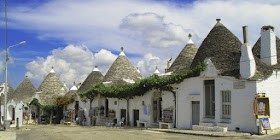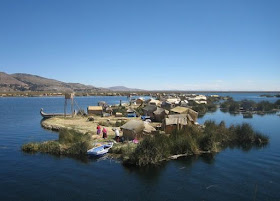While Langenveld, Austria is known for it's cross-country skiing, its here of all places, amid the snow covered mountains that visitors may rather choose to take a swim. Why? Its the location of the 4-star Aqua Dome Wellness Hotel. Here guests can choose from outdoor pools, saunas, baths and steam rooms for ways to relax.
The dome-ceilinged, glass-walled
thermal spring hall Ursprung (Origins) is the main indoor area with two
pools and a huge waterfall. From there, you swim via two canal pools to
the amazing outdoor area, Talfrische (Freshness Valley). With its
illuminated structures and steaming vessels it resembles the
potion-making lab of a gigantic but friendly sorcerer. The two canals
lead to a cone-shaped illuminated tower. From there you proceed to the
three bowl pools that look like gigantic martini glasses. Bobbing in
one of these eight-metre-high bowls that are 12 to 16 meters in
diameter, you can gaze upon the Alps and contemplate your good fortune (via).
The three levitating UFO-shaped outdoor pools are the most unique features of the Hotel. These pools were constructed to give the swimmer a further sense of weightlessness in addition to their natural buoyancy. The three pools consist of the whirl bowl, the sulfur bowl and the brine bowl. The whirl bowl has a whirlpool effect that is ideal for relaxation. In the sulphur bowl, sulphurous water runs into it every 15 minutes and massage benches can be found all around the edges. The brine bowl has a salt content of 5% with underwater music and light effects. The water temperature of the bowls varies between 32° to 36°.
The thermal indoor pools are just as impressive. Two big pools, filled with 34° and 36° Celsius warm, sulphurous thermal water makes for healthy bathing throughout the whole year. The Thermal indoor area also includes huge windows – that offers panoramic views of the surrounding nature – a waterfall, solaria and heat oasis.
Under the name Gletscherglühen, the Aqua Dome also offers an equally diversified and sophisticated sauna world. The earth sauna, inside a pine wood cabin, is extremely hot and can reach about 90°, however, because its half embedded into the earth, it makes the heat bearable. The other saunas include a glacier cave with ice rain and a stimulating Kneipp trail.
The Aqua Dome offers a separate water world for children and families, the Alpen Arche Noah. This area has two large swimming pools, a water slide, a playroom, an underwater camera and even a cinema. The hotel also has a fitness centre and offers hiking and activity programmes and is renowed for its fine dining and luxurious rooms.
Visit
The Aqua Dome Website for more information.

























